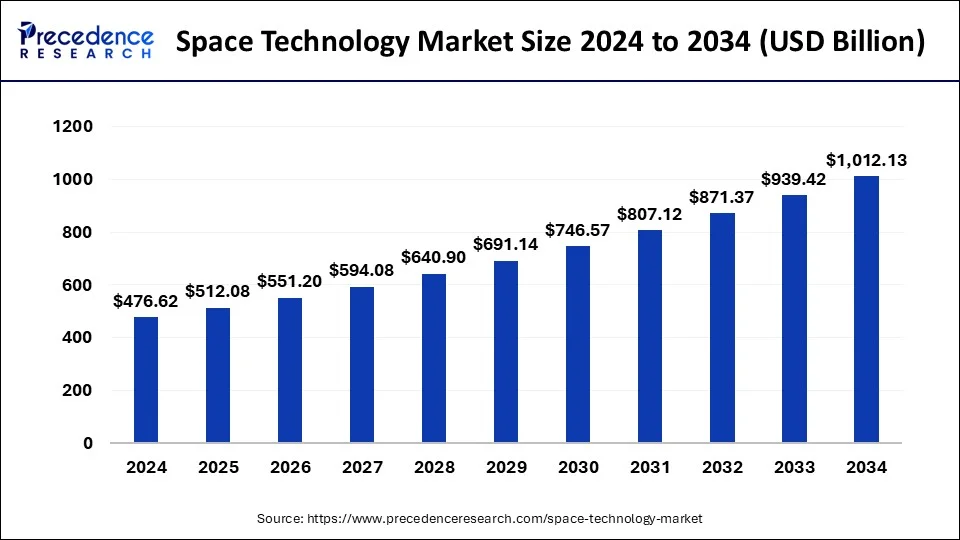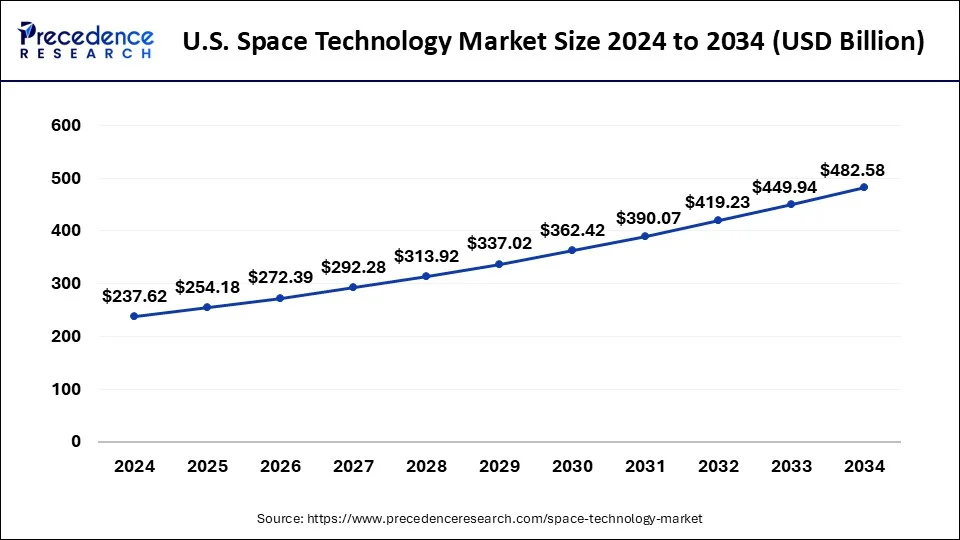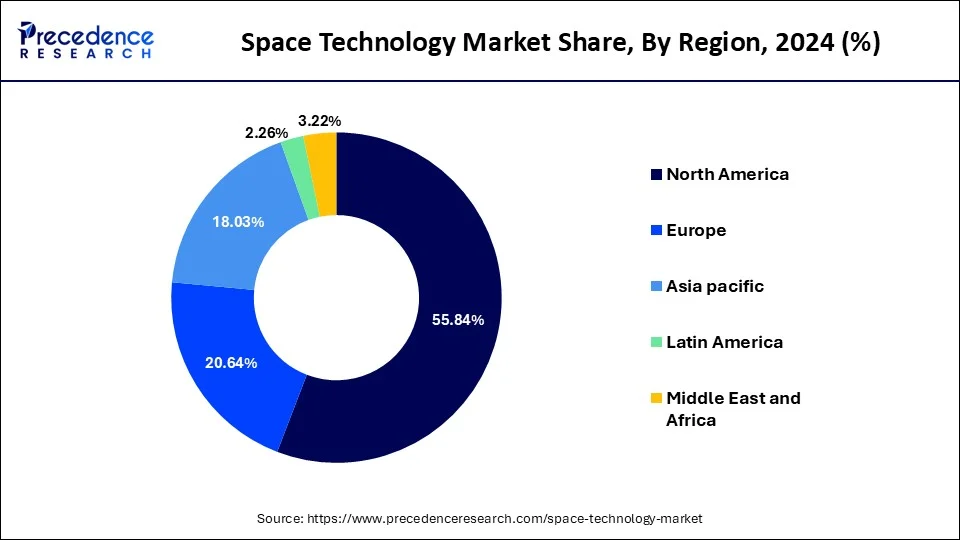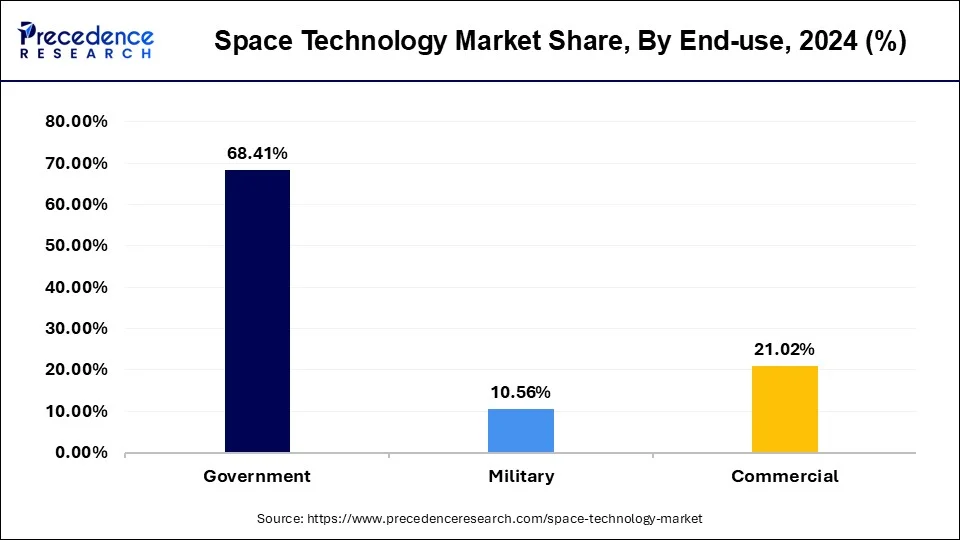December 2024
The global space technology market size is calculated at USD 512.08 billion in 2025 and is forecasted to reach around USD 1,012.13 billion by 2034, accelerating at a CAGR of 7.86% from 2025 to 2034. The North America space technology market size surpassed USD 266.15 billion in 2024 and is expanding at a CAGR of 7.53% during the forecast period. The market sizing and forecasts are revenue-based (USD Million/Billion), with 2024 as the base year.
The global space technology market size was estimated at USD 476.62 billion in 2024 and is predicted to increase from USD 512.08 billion in 2025 to approximately USD 1,012.13 billion by 2034, expanding at a CAGR of 7.86% from 2025 to 2034. Advancements in satellite technology, launch vehicles, and space exploration missions by commercial players, alongside government agencies, are actively contributing to the expansion of this market hence, aiding in the rapid growth of the space technology market.

The U.S. Space technology market size was estimated at USD 237.62 billion in 2024 and is projected to surpass around USD 482.58 billion by 2034 at a CAGR of 7.38% from 2025 to 2034.

North America accounted for the largest market share in 2024. The region has a dynamic and influential space technology market, offered by robust investments, technological innovation, and strategic partnerships. North America is home to renowned space agencies such as NASA (National Aeronautics and Space Administration) in the United States and the Canadian Space Agency (CSA) in Canada. These agencies spearhead groundbreaking missions, conduct cutting-edge research, and collaborate with international partners to advance space exploration. The region hosts a vibrant private sector, with companies like SpaceX, Blue Origin, and Lockheed Martin Space Systems driving innovation in space technology.
North America leads the way in commercial space activities, with a thriving ecosystem of startups and entrepreneurs exploring opportunities in satellite services, space tourism, asteroid mining, and beyond. Initiatives like NASA's Commercial Crew Program and Commercial Lunar Payload Services (CLPS) enable private companies to collaborate with government agencies on space exploration missions. The region fosters collaboration and partnerships among government agencies, academia, and industry stakeholders to drive innovation and tackle complex challenges in space exploration and technology development. Initiatives like the International Space Station (ISS) serve as platforms for international cooperation and scientific research.
The North American space technology market continues to experience robust growth, driven by increasing demand for satellite services, advancements in space exploration capabilities, and the emergence of new commercial opportunities. With ongoing investments, technological advancements, and a supportive regulatory environment, the region is poised to maintain its leadership position in the global space industry. The region's space technology market is specified by innovation, collaboration which aids in shaping the future of space exploration and its commercialization on a global scale.

Asia Pacific is emerging as a dynamic and rapidly growing hub for space technology, driven by a combination of technological advancements, increasing investments, and strategic partnerships. With a diverse array of countries and economies, the region offers unique opportunities for collaboration and innovation in the space industry. Countries in Asia Pacific, including China, India, Japan, and South Korea, have made significant strides in developing indigenous space capabilities. These nations have launched satellites for communication, Earth observation, navigation, and scientific research, which have proven their growing expertise in space technology. Governments across the region are ramping up investments in space exploration and technology development.
China's recent ambitious space program, which includes lunar exploration missions and plans for a space station, reflects the country's commitment to becoming a major player in space exploration.
ISRO is a renowned space exploration institute in Asia Pacific from India. Their programs, such as Mangalyaan and Chandrayan-3, have become widely popular due to their low budget and successful launch within the time frame. They are looking forward to the Gaganyan mission, which includes training and sending an Indian astronaut into space.
Asia Pacific is witnessing a surge in private sector participation in the space industry, with startups and companies focusing on satellite manufacturing, launch services, and space applications. Countries in the Asia-Pacific region are increasingly collaborating on space projects and initiatives, fostering regional cooperation and knowledge sharing. The Asia Pacific space technology market is poised for rapid growth, driven by increasing demand for satellite services, expanding space exploration programs, and the emergence of new commercial opportunities. With a large and diverse market, the region offers significant potential for companies involved in satellite manufacturing, launch services, and space-based applications.
While the Asia-Pacific region presents vast opportunities for the space industry, it also faces challenges such as regulatory hurdles, technological barriers, and geopolitical tensions. Overcoming these challenges will require collaboration among governments, industry stakeholders, and international partners to foster a conducive environment for innovation and growth. Hence, the region's space technology market is experiencing a period of exceptional growth and transformation, driven by government investments, the private sector, and regional collaboration. With its diverse capabilities and market potential, the region is poised to play a key role in shaping the future of space exploration and technology development.
Space technology and exploration of deep space were once restricted to the realm of science fiction. But it has become an increasingly significant sector in today's world. This market encompasses a wide range of technologies and services aimed at exploring, utilizing, and understanding space. In recent years, the space technology market has experienced rapid growth driven by advancements in satellite technology, launch vehicles, and space exploration missions.
This market includes satellite communications, weather forecasting by satellites, earth atmospheric observation, navigation systems, space tourism, and space exploration. Companies like SpaceX and Tesla are excellent examples of space exploration endeavours by humans, and their visionary work is immensely impressive, so that the masses are now more inclined towards space and its technology. These technologies find applications in telecommunications, agriculture, weather forecasting, navigation, and scientific research, among others.
The market's growth is fuelled by increasing demand for connectivity, data, and insights, as well as the emergence of new players and business models. With ongoing technological advancements and a growing interest in space exploration, the space technology market is expected to continue expanding in the following years. Commercial players, alongside government agencies, are actively contributing to the expansion of this market, driving innovation and competition.
| Report Coverage | Details |
| Growth Rate from 2025 to 2034 | CAGR of 7.86% |
| Market Size in 2025 | USD 512.08 Billion |
| Market Size by 2034 | USD 1,012.13 Billion |
| Largest Market | North America |
| Base Year | 2024 |
| Forecast Period | 2025 to 2034 |
| Segments Covered | Type, End-use, Application, and Region |
| Regions Covered | North America, Europe, Asia-Pacific, Latin America, and Middle East & Africa |
Satellite services
The increasing demand for satellite services across various industries is a significant driver of the space technology market. Satellites play a crucial role in providing communication, navigation, and Earth observation capabilities, driving the expansion of sectors like telecommunications, agriculture, transportation, and defense. Satellite-based navigation systems such as GPS are also an essential component of navigation, logistics, and location-based services.
With the growing need for global connectivity, businesses and governments depend on satellites for reliable communication networks, internet access, and data transmission. Many organizations are making efforts to create and design a space vehicle and launching pads that are robust enough to launch a bunch of satellites for various aims in one go. For instance, ISRO, a renowned space organization in India, has facilitated a program to launch satellites for many years to strengthen its position in the global space technology market.
The use of satellite imagery and data for Earth observation applications is gaining attention in markets like agriculture, environmental monitoring, urban planning, and disaster management. This data helps organizations make informed decisions and use optimal resources to respond effectively to evolving market conditions. Hence, the increasing reliance on satellite services across industries is a significant driver of growth in the space technology market, driving innovation, investment, and expansion in the global market.
Expensive endeavors
A major restraint for the space technology market is the high cost associated with developing and launching satellites and spacecraft. Despite advancements in technology and efforts to reduce costs, the design, manufacturing, testing, and launch of satellites remain expensive endeavors. Additionally, the infrastructure required for space missions, such as launch pads, ground stations, and mission control centers, adds to the overall cost.
These high costs can act as a barrier to entry for smaller companies and startups looking to enter the space industry. Furthermore, budget constraints faced by governments and organizations may limit their ability to invest in space exploration and satellite projects. Addressing cost constraints requires innovative approaches to spacecraft design, manufacturing, and launch services, as well as increased collaboration within the global market. While efforts are underway to lower costs through initiatives like reusable rocket technology and streamlined manufacturing processes, cost considerations remain a significant restraint for the space technology market.
Government expenditure on space programs has crossed the highest score globally by reaching a record-breaking amount of 117 billion USD in the year 2023. The U.S. government spends around USD 73.2 billion on its space programs, which are mainly run by the most popular organization, NASA.
Expansion of space exploration
A promising future opportunity for the space technology market lies in the continued expansion of space exploration and commercialization beyond Earth's orbit. As technology advances and costs decrease, the feasibility of missions to the Moon, Mars, and beyond becomes increasingly viable, with opportunities ranging from exploration and colonization to commercialization and innovation, paving the way for a new era of space exploration and utilization.
One significant opportunity is the establishment of lunar and Martian colonies for scientific research, resource extraction, and potentially even human habitation. Companies and governments are exploring the potential of utilizing resources such as water, ice, and minerals on the Moon and Mars to support future missions and sustain life. Moreover, the growing interest in space tourism presents another lucrative opportunity. Companies like SpaceX, Blue Origin, and Virgin Galactic are developing spacecraft capable of carrying passengers on suborbital and orbital flights. Such efforts are opening up the possibility of commercial space travel for private individuals.
Additionally, the continued demand for satellite services for communication, navigation, and Earth observation is expected to drive growth in the space technology market. As new applications and services emerge, such as satellite internet constellations and advanced remote sensing capabilities, opportunities for innovation and investment will be higher than today.
The space vehicles segment held the largest market share in 2024 and is expected to grow at the fastest pace in the upcoming years. Several factors have contributed to the growth of this segment, including the frequency of rising demand for satellite launches for various commercial reasons by private and government space organizations like ISRO, NASA, ESA, etc. Besides, reusable rocket technology is at its surge nowadays to make space exploration more reasonable, and commercialization will also be easy for laymen due to such technologies. To make it possible, many private organizations for space exploration are putting in vigorous efforts, such as Elon Musk’s SpaceX, has recently launched a reusable rocket on a test basis, and they were nearly successful in reusing the rocket for launching various satellites in one go.
Satellites are a crucial part of space exploration along with their various applications like earth observation to know the exact climatic conditions with real-time data, communications systems, research, etc. Reliable and efficient launching services are necessary to develop satellite-based services as demand for satellite services is higher than in past years. To facilitate satellite networks and services expansion, space vehicles have to be robust materially and technically, too, as they are used to transport payloads and satellites into space. Hence, in such cases, reusable rockets and their development have become a crucial part of the research and development for space exploration in the space technology market.
Space Technology Market Revenue, By Type 2022-2024 (USD Billion)
| Type | 2022 | 2023 | 2024 |
| Space Vehicles | 277.42 | 295.77 | 315.63 |
| Space Stations | 37.77 | 40.55 | 43.57 |
| Orbital Launch Vehicles | 51.62 | 55.30 | 59.29 |
| Deep-space communication | 15.10 | 16.18 | 17.35 |
| In-space Propulsion | 23.42 | 24.97 | 26.65 |
| Others | 12.45 | 13.26 | 14.13 |
The government segment dominated the market with the largest share in 2024 and is expected to sustain its position in the coming years. The growth of the segment can be attributed to the rising government programs supporting space missions. With the growing concerns about national security and disaster management, government agencies are investing heavily in developing innovative spacecraft. In addition, the rising government investments in space technology for military applications contribute to segmental growth.

Commercial bodies for space exploration have revolutionized the space industry by pushing an engineering boundary to develop innovative technology, such as reusable rockets, in the context of space missions. These agencies play a notable role by pioneering the technically advanced miniaturization of satellites, lightweight rockets, and autonomous systems used in the cockpit of rockets by integrating them with artificial intelligence. Such technically advanced systems can attract more consumers, making them available to access easily and affordable so that they can plot a broader range of missions of space exploration. Such innovations aid in thriving the space technology market by fostering the commercial end-use segment.
Space Technology Market Revenue, By Type 2022-2024 (USD Billion)
| End Use | 2022 | 2023 | 2024 |
| Government | 284.66 | 304.52 | 326.07 |
| Military | 44.82 | 47.48 | 50.34 |
| Commercial | 88.29 | 94.02 | 100.21 |
The navigation and mapping segment held the largest market share in 2024 and thus dominated. GPS means global positioning system, which is a widely renowned navigation and mapping system that occupies the everyday lives of people on a larger scale. Interestingly, the GPS principle is derived from the famous formula of Einstein's relativity equation. The global positioning system solely relies upon the constellation of satellites that are placed in an earth orbit in a geosynchronous position. This system helps users recognize the time and accurate positioning and navigation of information globally. This technology has been adopted by many sectors to provide accurate vehicle tracking, timing, route optimization, and location-based service with asset management.
Satellite communication is witnessing rapid growth after navigation and mapping and is anticipated to grow further, with the highest CAGR in the forecast period. Satellite communication play a crucial role in the context of global communication system as it acts as a bridge in between digitally divide communication system farther from each other in the different parts of the globe. Furthermore, satellites in low earth orbit and geostationary orbit are enabling internet access, voice/video calls, and data transfer.
Satellite communications support video streaming and digital content distribution, offering consumers access to a broader range of multimedia content by using social media platforms, which is now an integral part of human society. Integration of terrestrial networks with satellite communication facilitates seamless coverage for rural and urban areas by providing a higher network range for broadcasting and media distribution. Hence, TV and radio broadcaster's links reach the highest possible number of audiences nationally and internationally.
By Type
By End-use
By Application
By Geography
For inquiries regarding discounts, bulk purchases, or customization requests, please contact us at sales@precedenceresearch.com
No cookie-cutter, only authentic analysis – take the 1st step to become a Precedence Research client
December 2024
January 2025
February 2025
February 2025